Okja[1] is a South-Korean/American film about a girl called Mija and her best friend, a ‘super pig’ called Okja. When Okja gets taken by the company who made her, the Mirando corporation, Mija leaves her idyllic mountain-top home and goes on a dark adventure, determined to find Okja and bring her back home.
At the beginning of the film, Lucy Mirando of the Mirando corporation publicly announces her plans for a new ‘super’ meat to the press. Disguised as being “miraculously discovered on one Chilean farm” but actually genetically engineered, Lucy says that 26 super piglets (including Okja) will sent across the world, to be raised by local farmers. A capitalist marketing ploy, after 10 years they will crown one of the pigs the ‘best super pig’, and then “unveil” the super pigs to the world.
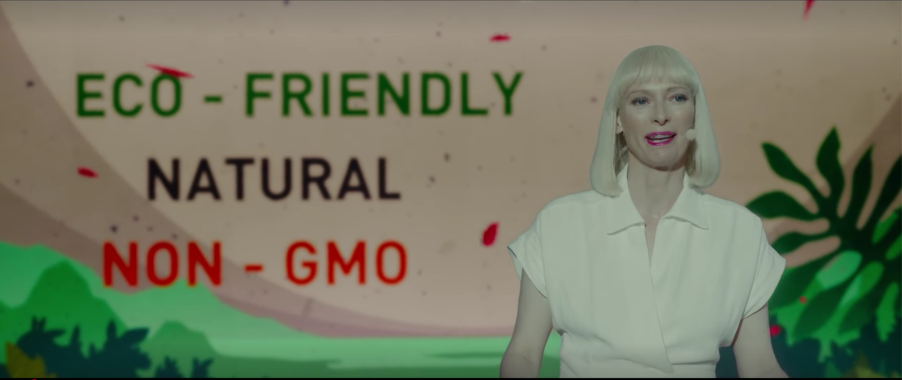
At the end of Lucy Mirando’s speech, Lucy refers to the well-known nursery rhyme ‘This Little Piggy’ when she says: “These little piggies will be the ancestors of a whole new species. Mamma natures gift. A revolution in the livestock industry”. Although it may appear that this is a cynical reworking of this well-loved childhood rhyme, the writer cleverly draws attention to the dark connotations of the original rhyme:
This little piggy went to market,
This little piggy stayed home,
This little piggy had roast beef,
This little piggy had none.
This little piggy cried
“Wee, wee, wee,”
All the way home![2]
This nursery rhyme can be read as a pig going to slaughter (‘market’), being made to eat beef (or being made to starve) and then crying, as the animal goes into the slaughterhouse (‘all the way home’). Although most modern versions of the rhyme have changed ‘cried’ to ‘went’, “wee, wee, wee” is an onomatopoeia for a pig crying, in every version. Therefore, this rhyme presents just how easy it is to disguise the cruelness of the agribusiness, within friendly and cute messaging. The films cinematic style of this scene parallels the nursery rhymes disguise. Using cute, cartoon pictures of happy animals, calm, cheerful music and lush green, natural colouring, the corporation’s advertisement covers up the brutal reality of its product. Lucy ends her speech with “And most importantly… They need to taste fucking good”. This perfectly sums up a world where animals are seen purely as a commodity and industry, dressed up as ‘eco-friendly’ and ‘natural’ in corporate, capitalist, manipulation.
This setting is then opposed to the succeeding scene, of rural South Korea, ‘10 years later, far from New York’, where we meet Mija and Okja. Away from civilisation, in the picturesque South Korean mountains, Mija and Okja are removed from any binary oppositions of ‘animal’ and ‘human’.
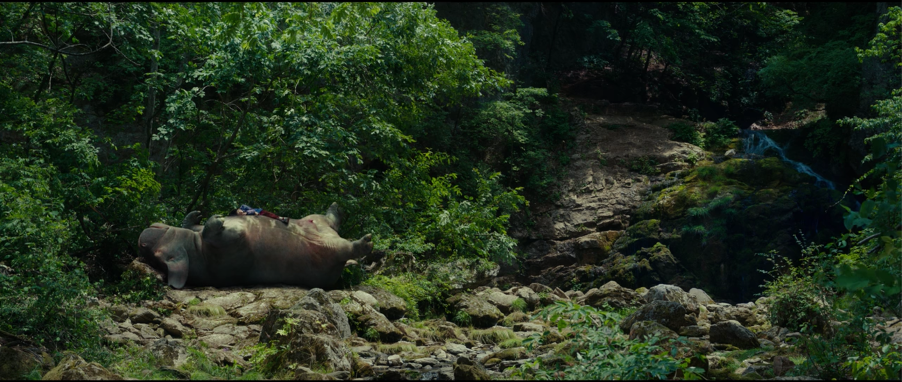
In the picture above you can see Okja, the super pig, sleeping on her back. On top of Okja, Mija is also sleeping. This visually presents the inseparable bond, and love, between Mija and Okja.
Animalistic diegetic sounds, of a cross between a pig and a horse, are used to present Okja’s animality. As horses have been adored, loyal companions to humans for centuries, these sounds are used to provoke further sympathy in the audience, towards Okja. Furthermore, although Okja cannot talk, we are shown that Mija and Okja can communicate, in their own way. Mija frequently responds to Okja’s noises and facial expressions, knowing what Okja needs, or feels, or wants. It is ambiguous to whether or not Okja’s cognition and intelligence is anthropomorphised, or animalised.
Although Mija is a human, and Okja is an animal, their biological difference is shown to be insignificant against greater oppositions, such as culture and language differences; the opposition of rich and poor; nature and capitalism. Mija is from a poor, agricultural background. Significantly, she cannot speak English, which puts her at a disadvantage, and causes her problems. Like Okja, she does not have a voice, in a lot of points throughout the film.
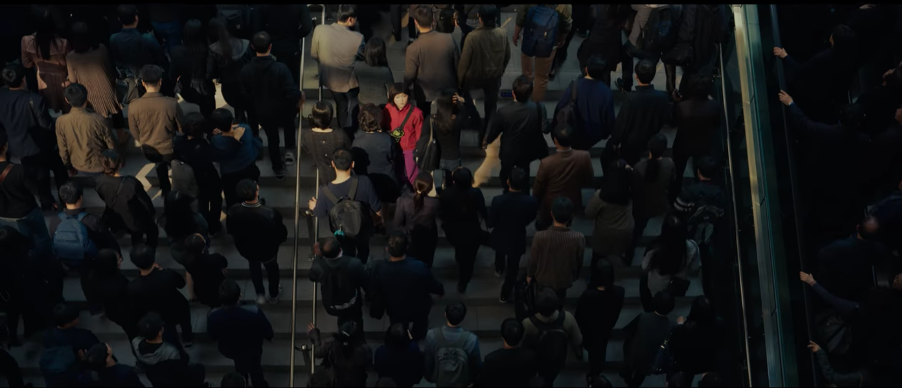
In the city, trying to find Okja, Mija stands out in her red jacket. Here the director cleverly and cinematically, using an aerial shot, highlights Mija’s ‘otherness’. The red symbolises the difference between herself, and the city goers around her. This scene references the little girl in red, from Schindler’s List[3]. One of the only moments of colour in Spielberg’s black and white film, the girl in red symbolises innocence amongst the horrors of the Holocaust. The red later serves to show the death of the girl, where the colour can be seen in a wheelbarrow, where the girl’s dead body lies. The use of this reference, and the symbol of red, in Okja, serves to highlight Mija’s innocence and ‘otherness’, whilst also suggesting that she might be in danger; naïve to the capitalist- driven society that surrounds her.
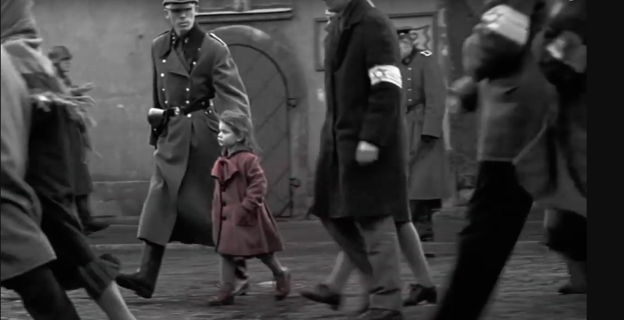
Mija and Okja parallel one another, both being shown as ‘other’, and looked down upon, by the cruel, capitalist meat industry. The biological difference between Okja and Mija is therefore shown to be irrelevant. It is Okja and Mija against the world; nature against capitalism; the poor and small, against the rich and powerful.
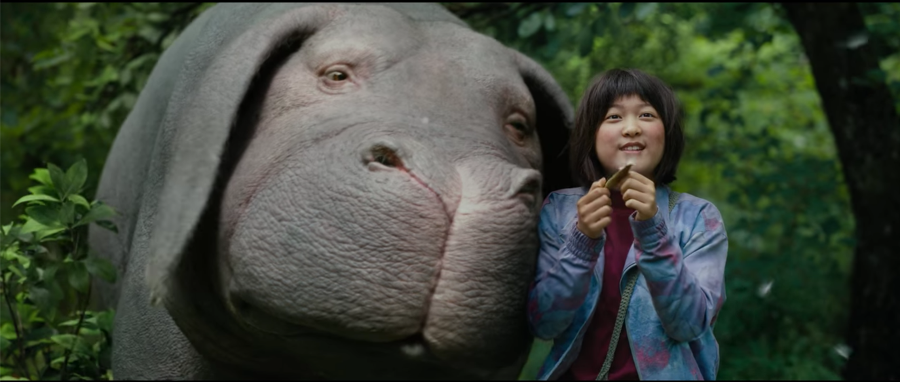
References:
[1] Okja, dir. by. Bong Joon-ho (Netflix, 2017)
[2] Poetry Foundation, ‘This Little Piggy’, Poetry Foundation <https://www.poetryfoundation.org/poems/46943/this-little-piggy> [Accessed 28th May 2020]
[3] Schindler’s List, dir. by. Steven Spielberg (Universal Pictures, 1993)
Bibliography:
Joon-ho, Bong, dir., Okja (Netflix, 2017)
Poetry Foundation, ‘This Little Piggy’, Poetry Foundation <https://www.poetryfoundation.org/poems/46943/this-little-piggy> [Accessed 28th May 2020]
Spielberg, Steven, dir., Schindler’s List (Universal Pictures, 1993)